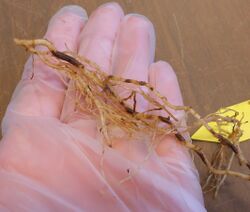Biology:Pyrenochaeta lycopersici
| Pyrenochaeta lycopersici | |
|---|---|

| |
| Tomato roots showing symptoms of corky root rot | |
| Scientific classification | |
| Kingdom: | |
| Phylum: | |
| Class: | |
| Subclass: | |
| Order: | |
| Family: | |
| Genus: | |
| Species: | P. lycopersici
|
| Binomial name | |
| Pyrenochaeta lycopersici R.W. Schneid. & Gerlach, (1966)
| |
Pyrenochaeta lycopersici is a fungal plant pathogen, infecting tomatoes and causing corky root rot.
Hosts and symptoms
The most susceptible host to Pyrenochaeta lycopersici is tomato, but the pathogen can also infect and cause damage to members of the families of Solanaceae and Cucurbitaceae such as pepper, eggplant, cucumber and melon.[1][2] Wilt, stunting and lack of vigor can be observed as the primary symptoms, and infected leaves can possibly show interveinal chlorosis that leads to premature defoliation.[3][4] The distinctive characteristic of P. lycopersici is that it causes brown lesions on the surface of medium roots which are known as a brown root rot.[4] In addition, the pathogen produces corky lesions on the large roots while rotting can be observed in the small roots.[2] Once the infection progresses, these lesions become wrinkled and dark brown, making cracks that prevent hosts from acquiring nutrients and water.[3][5] These results are often followed by the root failure which causes the reduction of tomato yield.[3][5]
Disease cycle
Most of the disease cycle for Pyrenochaeta lycopersici is not completely understood. P. lycopersici is an ascomycete that has not been observed to have a teleomorph stage.[6] It has been discovered that the pathogen is capable of producing pycnidia that produce conidia on conidiophores within the pycnidia.[6] However, these pycnidia have never been observed on the infected plants in nature. P. lycopersici makes microsclerotia, which are survival structures, on the roots of host plants in soil.[3][6] These microsclerotia can survive under harsh environments such as temperature changes and drought, and they can maintain the ability to infect other hosts in the soil for up to 15 years.[7] Once the environment becomes favorable for the pathogen growth, germination will occur in microsclerotia that leads to the production of hyphae.[6] The hyphae will penetrate and infect host roots through the epidermal cells.[3][6] Approximately 48 hours after the primary infection, the infected cells begin to die, causing symptoms including necrosis.[6] P. lycopersici keeps infecting neighboring cells until the roots are completely colonized, and corky root lesions can be observed upon its completion.[6]
Environment
The suitable soil temperature for Pyrenochaeta lycopersici to initiate the infection is in the range between 15 and 20 °C.[8][9] As the temperature increases above 18 °C, it is observed that there is less infection caused by the pathogen.[9] The corky root rot became one of the most serious diseases of tomato because growers used the inoculated soil without any type of disease management.[10] For instance, this occurred in Sweden when monoculture of tomatoes resulted in a yield reduction of 30-40%.[10]
References
- ↑ Grove, GG (1987). "Host range and survival in soil of Pyrenochaeta lycopersici". Plant Disease 71 (9): 806–809. doi:10.1094/pd-71-0806.
- ↑ 2.0 2.1 Golzar, H (2009). "First report of Pyrenochaeta lycopersici, causal agent of tomato corky root rot in Australia". Australasian Plant Pathology 4: 126–128.
- ↑ 3.0 3.1 3.2 3.3 3.4 Tsitsigiannis, DI; Antoniou, PP; Tjamos, SE; Paplomatas, EJ (2008). "Major diseases of tomato, pepper and eggplant in greenhouses". EJPSB (Special Issue 1): 106–124.
- ↑ 4.0 4.1 Kim, JT; Park, IH; Cheon, JU; Yu, SH (2003). "Corky root of tomato caused by Pyrenochaeta lycopersici in Korea". Plant Pathol J 19 (3): 181–183. doi:10.5423/ppj.2003.19.3.181.
- ↑ 5.0 5.1 Vitale, A; Castello, I (2011). "Reduction of corky root infections on greenhouse tomato crops by soil solarization in south Italy". Plant Disease 95 (2): 195–201. doi:10.1094/pdis-06-10-0418. PMID 30743410.
- ↑ 6.0 6.1 6.2 6.3 6.4 6.5 6.6 Aragona, M; Minio, A; Ferrarini, A; Valente, MT; Bagnaresi, P; Orru, L; Tononi, P; Zamperin, G et al. (2014). "De novo genome assembly of the soil-borne fungus and tomato pathogen Pyrenochaeta lycopersici". BMC Genomics 15: 313. doi:10.1186/1471-2164-15-313. PMID 24767544.
- ↑ Ekengren, SK (2008). "Cutting the gordian knot: taking a stab at corky root rot of tomato". Plant Biotechnology 25 (3): 265–269. doi:10.5511/plantbiotechnology.25.265.
- ↑ Campbell, RN (1982). "Corky root of tomato in California caused by Pyrenochaeta lycopersici and control by soil fumigation". Plant Disease 66 (8): 657–661. doi:10.1094/pd-66-657.
- ↑ 9.0 9.1 Termohlen, GP (1962). "On corky root of tomato and the corky root fungus". T. Pl. -ziekten 68: 295–367.
- ↑ 10.0 10.1 Hasna, MK (2009). "Management of corky root rot disease of tomato in participation with organic tomato growers". Crop Protection 28 (2): 155–161. doi:10.1016/j.cropro.2008.09.011.
External links
Wikidata ☰ Q3926073 entry
 |

